Understanding Duplicate Content in eCommerce: What It Is, Why It Happens, and How to Fix It

Patrizia Medina
Senior Project Manager
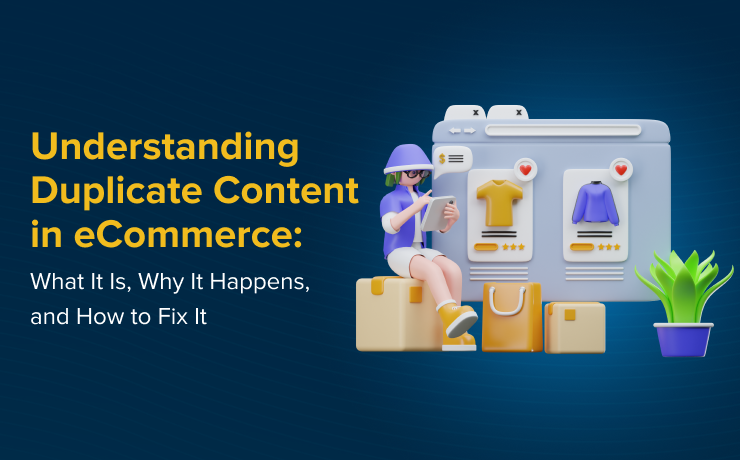
If you’re starting out with SEO for the first time, one of the most confusing and often overlooked issues is duplicate content. Especially in eCommerce, this is a common challenge, and it can quietly hurt your site’s search engine rankings. Fixing duplicate content in eCommerce gives your site a better foundation to grow and rank better.
In this guide, we’ll explain what duplicate content is and why it’s especially common on online stores. More importantly, we’ll show you how to fix these issues so your website performs better in search.
How Duplicate Content in eCommerce Hurts Your Search Performance
Search engines rely on clarity. When multiple pages appear nearly identical, users struggle to decide which version should be displayed in search results. This confusion can limit your visibility, reduce link value, and cause important product pages to get buried.
Duplicate content issues are usually unintentional for eCommerce websites. They’re the result of how products are displayed, filtered, or described, but they still impact performance. Understanding how duplicate content works is the first step to fixing it.
What is Duplicate Content?
Definition
Let’s start simple: Define duplicate content.
Duplicate content refers to blocks of text or pages that are either identical or very similar and appear on more than one URL, either within the same website or across different websites.
In SEO terms, duplicate content issues occur when Google identifies multiple pages with similar content and cannot determine which one to display in search results.
Real-World Example
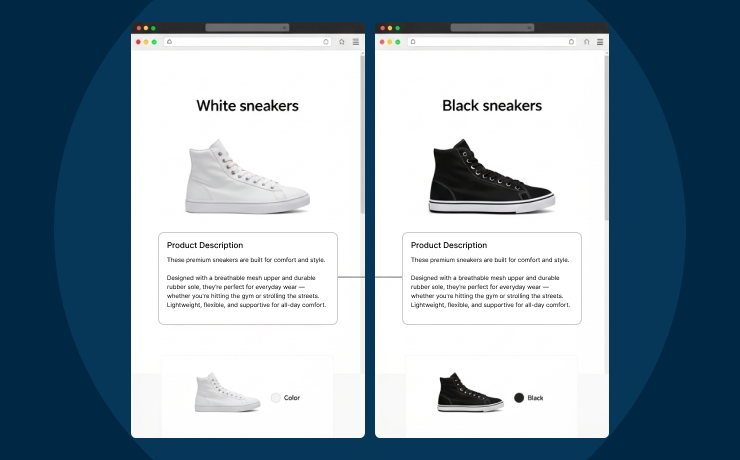
Imagine you sell sneakers online and have multiple product pages for each size or color. If every page uses the same description, images, and details, search engines may treat them as duplicate content. Even though you know these are different products, Google might just see them as near-identical pages.
Why Duplicate Content is Common in eCommerce
Duplicate content eCommerce issues are everywhere, and they’re often unintentional. Let’s look at some reasons why it happens so often in online stores.
1. Dynamic URLs and Session IDs
Ecommerce platforms love to create dynamic URLs with session IDs, tracking tags, or referral codes. Even if the content doesn’t change, each URL is unique.
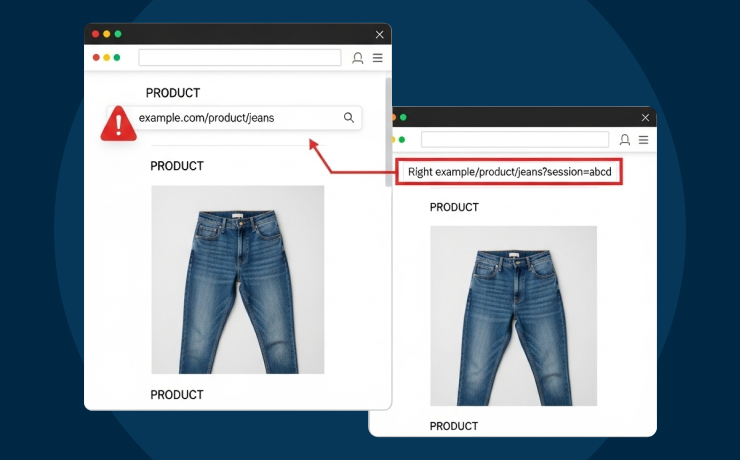
- example.com/product/jeans
- example.com/product/jeans?session=abcd
Google treats those as two separate pages, even if they look the same. That’s classic SEO eCommerce duplicate content.
2. Faceted Navigation (Filters & Sorting)
Filters like “Color: Blue” or “Sort by: Price” often generate new URLs. However, the content stays mostly the same. This creates dozens (or hundreds) of similar pages Google must crawl and decide between.
3. Product Variations
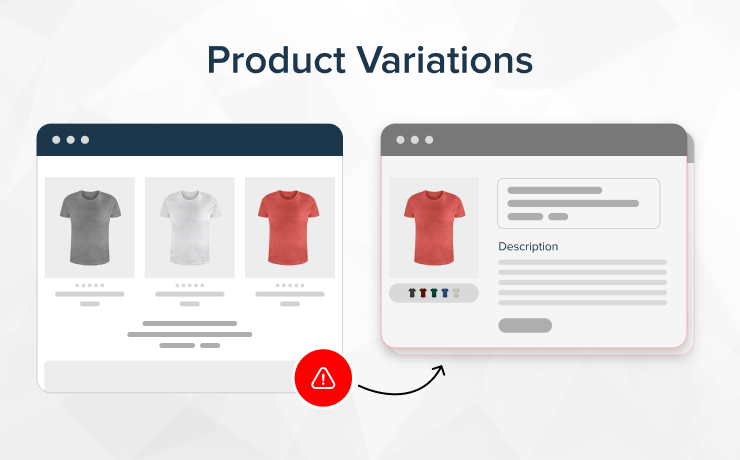
Let’s say you sell a jacket in five sizes and three colors. Some stores create separate pages for each variation, leading to nearly identical content across all those URLs.
4. Manufacturer Product Descriptions
This is a big one: copying product descriptions directly from the manufacturer. If 50 other stores do the same, your content is no longer unique.
5. Pagination Issues
Many category pages span multiple pages. Without proper handling, those paginated URLs can appear as duplicates. They can reflect the same title tags, meta descriptions, and similar content.
SEO Risks of Duplicate Content
So, does duplicate content hurt SEO?
Yes, but perhaps not in the way you think.
Google says it doesn’t penalize websites for duplicate content unless it looks manipulative. But even without a penalty, there are still serious SEO consequences.
Let’s walk through what can go wrong:
1. Pages Compete with Each Other
When multiple pages share similar content, Google has to choose which one to rank. That means your own pages could be fighting each other instead of working together.
2. Diluted Link Equity
If backlinks point to different versions of the same content, your SEO strength is spread thin. This dilutes your site’s authority and can impact your rankings.
3. Crawling Budget Waste
Google only spends a certain amount of time crawling your site. If that time is used on duplicate pages, it may ignore more important ones.
4. Deindexing Important Pages
In some cases, Google may choose not to index a page it sees as a duplicate, which could mean your best product pages aren’t showing up in search.
5. Confusion for Search Engines
So, does duplicate content affect SEO? Absolutely. It confuses Google, spreads ranking signals across multiple URLs, and weakens your site’s overall performance.
Easy Fixes for Duplicate Content
Let’s look at how to fix duplicate content issues on your eCommerce site — even if you’re just getting started.
A. Use Canonical Tags
A canonical tag tells search engines, “This is the main version of this page.”
If you have multiple URLs with the same content (like product variations or filtered listings), you can use a canonical URL duplicate content solution to consolidate ranking power.
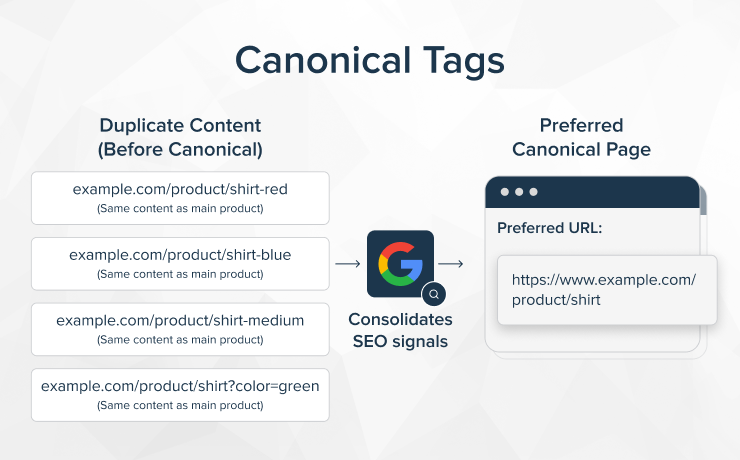
Add this to the <head> section of your preferred page:
Html
CopyEdit
<link rel=”canonical” href=”https://www.example.com/product/shirt” />
This allows Google to determine which version to rank, thereby reducing confusion and duplication.
B. Implement 301 Redirects
A 301 redirect sends users and search engines from an old or duplicate page to your main, preferred version.
This is especially helpful if you’ve cleaned up old pages or consolidated product listings. It ensures you don’t lose the SEO value those pages have already built.
C. Set URL Parameters in Google Search Console
If your URLs use parameters for filters or sorting (like ?color=red&sort=price), you can guide Google on how to handle them.
In Google Search Console, go to the URL Parameters tool and set rules for how those parameters should be treated. This helps reduce the risk of SEO duplicate content from faceted navigation.
D. Set Up Product Variants on One Page
Instead of having separate pages for each color or size, combine all options into a single product page using dropdown menus or selectors.
This not only improves user experience but also reduces the number of nearly identical pages — a key fix for duplicate content SEO problems.
E. Write Unique Descriptions for Each Product
Resist the urge to copy-paste. Write original, keyword-rich descriptions that reflect your brand’s tone and speak directly to your customers.
Unique content helps differentiate your products and also boosts your visibility in search results.
F. Handle Pagination Properly
Paginated category pages can confuse search engines if not managed correctly.
Use the rel=”next” and rel=”prev” tags in the page headers, or, if appropriate, canonicalize all pages to the main category landing page.
This prevents those pages from being seen as duplicates of one another.
G. Use Robots.txt (Carefully)
The robots.txt file tells search engines what they can and cannot crawl on your site.
Block crawling of non-essential URLs (like sort filters), but make sure important pages are still accessible and indexable. Misusing this can hide valuable content from Google.
Turning Duplicate Content Into SEO Wins
So, what is duplicate content, and why should you care?
In short, duplicate content happens when similar or identical content appears at multiple URLs. In eCommerce, it’s easy to accidentally create this through product filters, variations, or reused descriptions. And while Google won’t punish you harshly, duplicate content affects SEO by causing ranking confusion, wasting crawl budget, and diluting your site’s authority.
Thankfully, you now know how to fix duplicate content issues:
- Use canonical tags to declare the master page.
- Redirect duplicates with 301s.
- Consolidate product variants.
- Write unique content.
- Manage parameters and pagination wisely.
Fixing these issues is good for your customers, too. They’ll find your products more easily and enjoy a smoother shopping experience.
Need help spotting duplicate pages on your store? Tools like Screaming Frog, Sitebulb, and Ahrefs Site Audit can scan your site and highlight where the problems are.
Now that you understand duplicate content SEO, you’re one step closer to a better-performing, higher-ranking online store.
Duplicate content in eCommerce sites also impacts your customers’ experience. With the right strategy and tools, you can resolve these issues and improve your site’s speed, appearance, and visibility in search results.
At SmartSites, we help online stores solve these exact problems every day. From technical SEO audits to eCommerce SEO strategies, we’re here to help you remove duplicate content, optimize your site, and grow your traffic the right way.
Ready to fix duplicate content on your store and take back control of your rankings? Let’s talk about where your SEO should be heading next.
 Free
Consultation
Free
Consultation Free
Google Ads Audit
Free
Google Ads Audit







